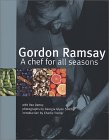|
More Than One-Star Food in a Three-Star Presentation
Gordon Ramsay, a Chef for All Seasons
In pointing out that gifted chefs who fail to hire cunning PR representation usually languish in utter, delicious, and peaceable obscurity while those who do don't, I do not intend to suggest that celebrity chef -- and presently "author"--Ramsay's cookery isn't worth considering; I merely make note of the fact that only time will reveal if there is far less to the Ramsay phenom than meets the eye. British press reports, mixed, hint as much. In the London Sunday Times, celebrity-cum-journalist Michael Winner, whose knowledge of cuisine in no way exceeds his ample girth, celebrates Ramsay's skill; meanwhile, the serious, informed, and tart-tongued restaurant critic A. A. Gill leaves our bonny Gordon's efforts dissed, dismissed, and dumped on. And then there is the gossip column item one of the London tabloids carried shortly after the opening of Ramsay's much-touted Aubergine. It seems a food writer booked in incognito. On arrival her party was shown to a table and " ... was promptly forgotten by the staff. After 43 minutes of non-activity, the resilient and enterprising lady took out her mobile phone, rang the restaurant, asked to be connected with Ramsay. 'Good evening,' he said. 'What can I do for you?' 'Well,' she replied, 'you could start by having someone bring us some menus.' " Ramsay, not menus, is the focus of his new book, "Gordon Ramsay, A chef for all seasons." Writer Denny has divided the book into four sections, one for each season. Each opens with Ramsay's observations and notes about the ingredients then available. The theme of the collection is freshness and seasonality -- here more of a nod to a current trend in cookbookery than substantive. Also included is an appendix with basic recipes and a few useful techniques shown in step-by-step photographs. Recipes -- most of them breathtakingly illustrated -- are arranged by season. "Ramsay" introduces each quarter of the year with ramblings on his favorite foods which, for the most part, form the foci of the concoctions that follow. These are stylish but are made to appear simple to produce. Happily, measurements are in familiar US units of weight, volume, and temperature; ingredients are, for the most part, readily available. I found seven I intend to try: duck breasts with endive tarts; whiting with a lemon-parsley crust; pillow of ricotta gnocchi with feves and peas; light tomato broth with a paysanne of vegetable; salad of cepes and langoustine in mustard dressing; tomato and parmesan gratinee tarts; and sweetbreads with shallot and mushroom marmalade. In quest of articulating flavor -- clarifying and, so, revealing it -- Ramsay's combinations of ingredients are betimes surprising but not always successful. For instance, one recipe I experimented with last fall, an upside down apple tart calling for five-spice powder, proved a dud. Like many new cookbooks published in the UK before appearing in US bookstores, Ramsay's beautifully produced book is a visual delight, his ideas perfectly articulated in handsome easy-to-follow typography and luminous, stunningly simple yet powerfully evocative photographs. Here is a book that seems to open a door to a kitchen adventure. Clearly, this is something more than one-star food in a three-star presentation. As clear is the nagging feeling that there is something at work here that I mistrust. What it is is hard to say. Perhaps my ineffable misgivings have something to do with what F. Scott Fitzgerald thought of as the arriviste who never quite arrives. I would like to like this book but for all of my desire, a qualm nevertheless obtains. It leaves me wondering what our Gordon might have done with his time on the Eighth Day. March 2001
|
 The history of gastronomy is largely the history of adults playing with fire. Yes, every once in a while a brat sets off a fresh spark to separate people from money. But, over time, these prove masters more of the flash than of the pan. I am inclined to count among such Scotsman and badass wannabe Gordon Ramsay . By the age of 26 he had acquired not only a disputatious and carefully cultivated reputation for elevating hubris to the status of a religion and practicing it with the zeal of a true believer but, also, more Michelin stars (four) than most serious kitcheners earn in a lifetime.
The history of gastronomy is largely the history of adults playing with fire. Yes, every once in a while a brat sets off a fresh spark to separate people from money. But, over time, these prove masters more of the flash than of the pan. I am inclined to count among such Scotsman and badass wannabe Gordon Ramsay . By the age of 26 he had acquired not only a disputatious and carefully cultivated reputation for elevating hubris to the status of a religion and practicing it with the zeal of a true believer but, also, more Michelin stars (four) than most serious kitcheners earn in a lifetime.